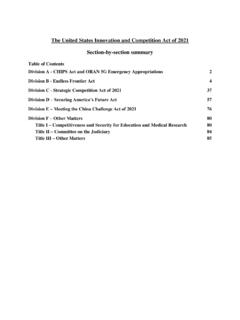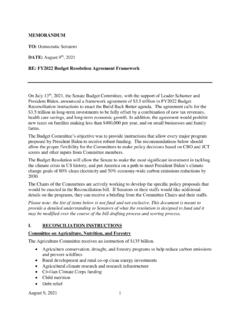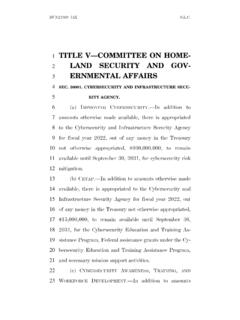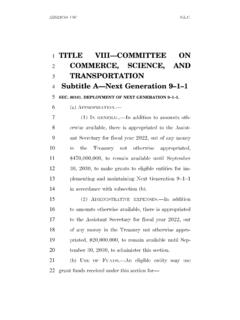Transcription of The United States Innovation and Competition Act of 2021
1 1 The United States Innovation and Competition Act of 2021 Division-by-division summary Table of Contents Division A CHIPS and ORAN 5G Emergency Appropriations .. 2 Division B Endless Frontier Act .. 4 Division C Strategic Competition Act of 2021 .. 8 Division D Homeland Security and Governmental Affairs Committee Provisions .. 9 Division E Meeting the China Challenge Act of 2021 .. 10 Division F Other Matters .. 11 Title I Competitiveness and Security for Education and Medical Research .. 11 Title II Committee on the Judiciary Provisions .. 13 Title III Miscellaneous .. 14 2 Division A CHIPS and ORAN 5G Emergency Appropriations Emergency Supplemental Appropriations to Implement the CHIPS for America Act Summary The share of semiconductors and microelectronics manufactured in the United States has fallen in recent decades.
2 While the represented 37% of global semiconductor manufacturing capacity in 1990, today just 12% of semiconductors are manufactured in the , and many foreign competitors, including China, are investing heavily to dominate the industry. In order to preserve our competitive edge, the Fiscal Year 2021 (FY21) National Defense Authorization Act (NDAA) included bipartisan provisions based on the bipartisan CHIPS for America Act and the bipartisan American Foundries Act to encourage the development of domestic semiconductor manufacturing capabilities and ensure the stay on the cutting-edge of the industry with R&D. In particular, the bipartisan FY2021 NDAA semiconductor provisions: Established a Department of Commerce incentive program to provide financial assistance to build, expand, or modernize commercial semiconductor fabrication, assembly, testing, advanced packaging, and R&D facilities in the Provided support for domestic microelectronics industry, including new R&D programs at the Department of Defense.
3 Authorized a multilateral semiconductor fund to support the adoption of a secure semiconductor supply chain and greater alignment of export control and other related politics among partner countries. Created a National Semiconductor Technology Center, a National Advanced Packaging Manufacturing Program, and additional R&D programs at the Department of Commerce to conduct research, prototyping, and workforce training in advanced semiconductor technology with private sector and interagency participation. There is an urgent need for our economic and national security to provide funding to swiftly implement these critical programs. The Chinese Communist Party is aggressively investing over $150 billion in semiconductor manufacturing so they can control this key technology. At the same time, halted domestic production lines for consumer technology, auto manufacturers, truckers, and other critical industries due to a semiconductor shortage underscores the vulnerability the faces and points to the need to act quickly to implement these bipartisan provisions.
4 Supplemental Appropriations: In order to support the rapid implementation of the semiconductor provisions included in the FY21 NDAA, the amendment provides $52 billion in emergency supplemental appropriations to implement these programs. This includes: $ billion allocated over 5 years for a CHIPS for America Fund. Funding must be used to implement the Commerce Department semiconductor incentive and R&D 3 programs authorized by the FY21 NDAA (Sec. 9902 & 9906). Within the fund, the following appropriations are available: o Incentive Program: $39 billion appropriated upfront and allocated over 5 years to implement the programs authorized in Sec. 9902. $2 billion is provided to solely focus on legacy chip production to advance economic and national security interests, as these chips are essential to the auto industry, the military, and other critical industries.
5 $19 billion in FY22, including the $2 billion legacy chip production funding $5 billion each year, FY23 through FY26 o Commerce R&D programs: $ billion appropriated upfront and allocated over 5 years to implement programs authorized in Sec. 9906, including the National Semiconductor Technology Center (NSTC), National Advanced Packaging Manufacturing Program, and other R&D programs authorized in Sec. 9906. $5 billion in FY22 $2 billion for NSTC $ billion for advanced packaging $500 million for other related R&D programs For use across the NSTC, advanced packaging, and other related R&D programs, the following would be provided: $2 billion in FY23 $ billion in FY24 $ for FY25 and FY26 $2 billion for a CHIPS for America Defense Fund: Funding is appropriated up front and $400 million is allocated each year, over 5 years for the purposes of implementing programs authorized in Sec.
6 9903(b), providing support for R&D, testing and evaluation, workforce development, and other related activities, in coordination with the private sector, universities, and other Federal agencies to support the needs of the Department of Defense and the intelligence community. $500 million for a CHIPS for America International Technology Security and Innovation Fund: Funding is appropriated upfront and $100 million each year, allocated over 5 years to the Department of State, in coordination with the Agency for International Development, the Export-Import Bank, and the International Development Finance Corporation, for the purposes of coordinating with foreign government partners to support international information and communications technology security and semiconductor supply chain activities, including supporting the development and adoption of secure and trusted telecommunications technologies, semiconductors, and other emerging technologies.
7 The Utilizing Strategic Allied (USA) Telecommunications Act Summary 4 Heavily subsidized by the Chinese government, Huawei is poised to become the leading commercial provider of 5G, with far-reaching effects for economic and national security. With close ties to the Communist Party of China, Chinese state-directed technology companies like Huawei present unacceptable risks to our national security and to the integrity of global information networks. For several years, Congress has been evaluating how to shore up the global telecommunications supply chain and limit the scope of Huawei s involvement globally. These efforts have illustrated how current terms of Competition favor Huawei. Further, efforts to convince foreign partners to ban Huawei from their networks have stalled amid concerns about a lack of viable, affordable alternatives.
8 Without significant investment in the development of Western-based alternatives, Huawei stands poised to become the cheapest, fastest, most ubiquitous global provider of 5G. Supplemental Appropriations: The Utilizing Strategic Allied (USA) Telecommunications Act was enacted in the FY2021 NDAA. It fosters Innovation in the race for 5G and invests in Western-based alternatives to Chinese equipment providers Huawei and ZTE. The USA Telecom Act plays to American strengths by capitalizing on software advantages, accelerating development of an open-architecture model (known as OpenRAN) that would allow for alternative vendors to enter the market for specific network components, rather than having to compete with Huawei end-to-end. OpenRAN not only has the support of US carriers, it has the support of US vendors of all sizes, along with a range of non-traditional vendors and technology firms.
9 In order to further support the implementation, Senators Warner and Rubio are proposing an amendment which would provide $ billion in emergency supplemental appropriations to implement the USA Telecom Act, including: $ billion for the Public Wireless Supply Chain Innovation Fund to spur movement towards open-architecture, software-based wireless technologies, funding innovative, leap-ahead technologies in the mobile broadband market. The fund would be managed by the National Telecommunications and Information Administration (NTIA), with input from the NIST, DHS, and IARPA, among others. The $500 million CHIPS for America International Technology Security and Innovation Fund will also support activities authorized in the USA Telecommunications Act, through the Fund s support of international information and communications technology security and semiconductor supply chain activities, including supporting the development and adoption of secure and trusted telecommunications technologies, semiconductors, and other emerging technologies.
10 Division B Endless Frontier Act The Endless Frontier Act, as reported by the Senate Commerce Committee, seeks to maintain and build on science and technology leadership through investments in research and 5 development and strengthening regional economic development, manufacturing, and supply chains. The legislation would authorize roughly $120 billion over 5 years for activities at the National Science Foundation ( NSF ), Department of Commerce ( DOC ), the Department of Energy ( DOE ), and the National Aeronautics and Space Administration ( NASA ). The Endless Frontier Act advances priorities including to reduce undue geographic concentration of R&D funding, encourage broader participation of populations underrepresented in STEM, and increase collaboration across federal agencies and with non-governmental partners on Innovation . Notable Provisions: Technology Directorate (Title I) The Endless Frontier Act would create a new Directorate of Technology and Innovation at the NSF to support research and technology development in key technology focus areas, such as artificial intelligence and quantum science, in order to strengthen the global leadership of the United States in Innovation .










